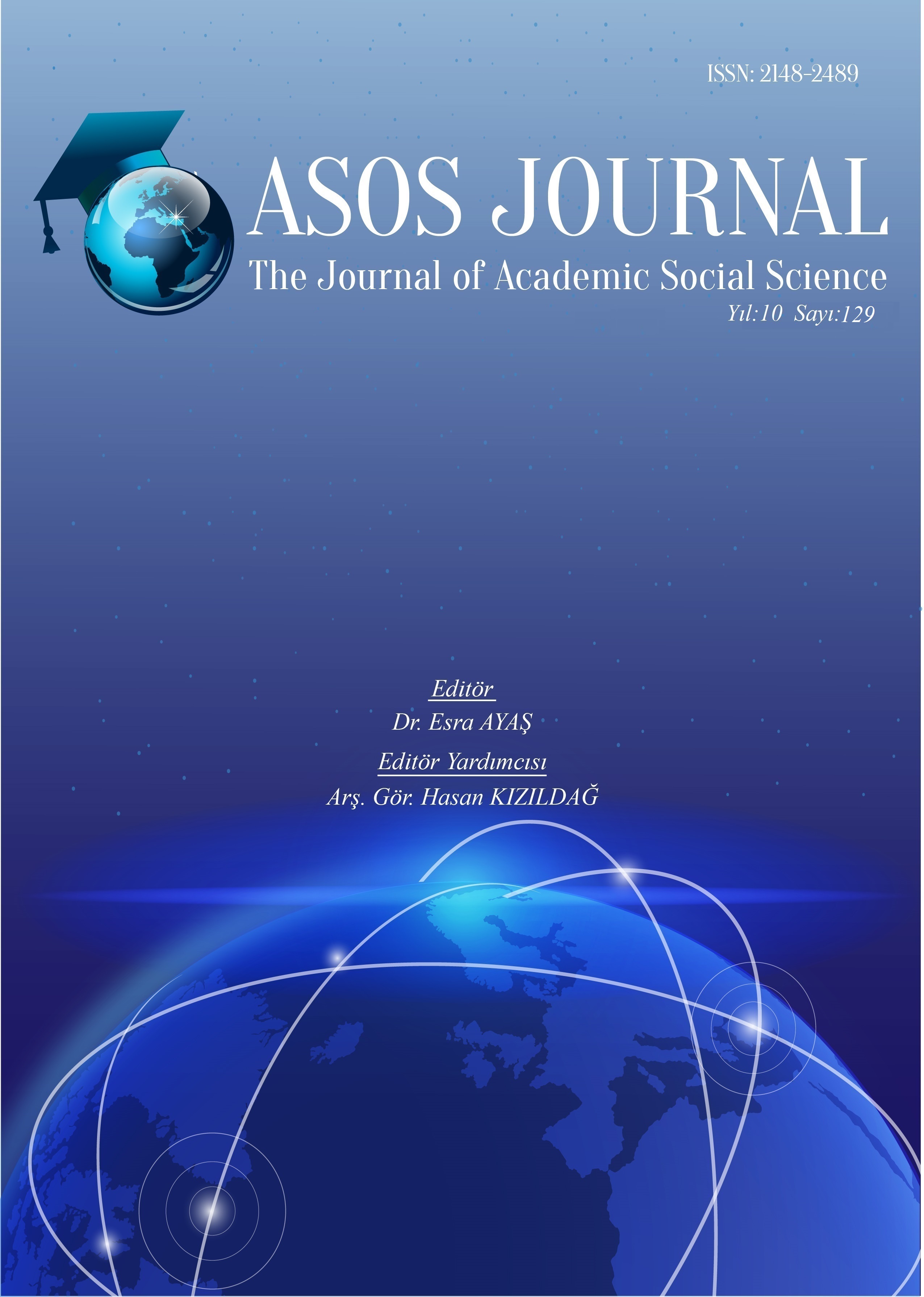Author :
Abstract
Bu çalışmada örnekleme yöntemi ile seçilen bir grup bilim ve sanat merkezi destek grubu öğrencilerinin üç boyutlu kavram görüntüleri ve cisim imgeleri, çizim yöntemi ile ortaya konulması amaçlanmıştır. Bu amaca uygun olarak Ordu ili ve ilçelerinde bilim ve sanat merkezlerinde öğrenim gören destek grubu öğrencilerinden 134 kişi ile çalışma yürütülmüştür. Çalışmaya katılan öğrencilerden küp, silindir, dikdörtgenler prizması ve kare piramit çizerek isimlerini belirtmeleri istenmiştir. Öğrencilerin bu konudaki bilgilerini özgürce ifade edebilmelerini sağlamak için herhangi bir kalıp öne sürülmemiş konuyu ifade eden her türlü çizim ve adlandırmanın uygulanabileceği belirtilmiştir. Öğrencilere bu uygulama için 20 dakika süre verilmiştir. Veri toplama yöntemi olarak görüşme formu yönerge ile birlikte çocuklara verilmiştir. Toplanan veriler hazırlanan değerlendirme tablosu kapsamında her bir geometrik cisim için ayrı ayrı değerlendirilmiştir. Alınan sonuçlara göre çocukların üç boyutlu düşünme ve geometrik cisim imgeleri konusunda yetersiz oldukları ve yanlış imgelere sahip oldukları görülmüştür.
Keywords
Abstract
In this study, it was aimed to present three-dimensional concept images and object images of a group of science and art center support group students selected by sampling method by drawing method. In line with this purpose, a study was conducted with 134 support group students studying at science and art centers in Ordu and its districts. The students who participated in the study were asked to name a cube, cylinder, rectangular prism and square pyramid by drawing. It was stated that in order to enable students to express their knowledge on this subject freely, any drawing and naming can be applied to express a subject that has not been put forward. Students were given 20 minutes for this application. As a data collection method, the interview form was given to the children together with the instruction. The collected data were evaluated separately for each geometric object within the scope of the evaluation table prepared. According to the results, it was seen that the children were insufficient in three-dimensional thinking and geometric body images and had wrong images.
Keywords
- Baki, A., Bell, A. (1997). Ortaöğretim Matematik Öğretimi. Ankara: YÖK/Dünya Bankası. 3.105- 106.
- Bartoszeck, A. B., Machado, D. Z., & Amann-Gainotti, M. (2008). Representations of internal body image: a study of pre-adolescents and adolescent students in Araucaria, Paraná, Brazil. Ciências & Cognição, 13(2), 139-159.
- Baykul, Y. (2002). İlköğretimde matematik öğretimi. Ankara: Pegem A Yayıncılık.
- Berkün, M. (2011). İlköğretim 5 ve 7. sınıf öğrencilerinin çokgenler üzerindeki imgeleri ve sınıflandırma stratejileri (Yayımlanmamış Yüksek Lisans tezi, Dokuz Eylül Üniversitesi Eğitim Bilimleri Enstitüsü).
- Burger, W. ve Shaughnessy, J.M. (1986). Characterizing the van Hide levels of development in geometry, Journal for Research in Mathematics Education, 16, 31-48.
- Erez, M. & Yerushalmy, M. (2006) “If you can turn a rectangle into a square, you can turn a square into a rectangle”: young students’ experience the dragging tool. International Journal of Computers for Mathematical Learning, 11(3), 271-299.
- Gutierrez, A. (1992). Exploring the links between van Hiele levels and 3 dimensional geometry, Structural Topology, 18, 31-48.
- Konyalıoglu, A. C. (2003). Üniversite düzeyindeki vektör uzayları konusundaki kavramların anlaşılmasında görselleştirme yaklaşımının etkinliğinin incelenmesi. Yayınlanmamıs Doktora Tezi Atatürk Ünversitesi Fen Bilimleri Enstitüsü.
- Nemirovsky, R. & Noble, T. (1997). On mathematical visualization and the place where we live. Educational Studies in Mathematics 33(2), 99–131
- Okazaki, M. & Fujita,T. (2007) . Prototype Phenomena and Common Cognıtıve Paths in the Understanding of the Inclusion Relations Between Quadrilaterals in Japan and Scotland. In J. Woo, H. Lew, K. Park & D. Seo (Ed), Proceedings of the 31st Conference of the Internatıonal Group for the Psychology of Mathematics Education: 4, 41-48.
- Olivier, A. (1989). Handling Pupils’ Misconceptions, 13. Ulusal Matematik ve Fen Bilimleri, Biyoloji Eğitimi Kongresi, Pretoria http://www.wcape.school.za/malati/Misconceptions.htm (2003)
- Olkun, S. ve Aydoğdu, T. (2003). Üçüncü uluslararası matematik ve fen araştırması (TIMSS) nedir? Neyi sorgular? Örnek geometri soruları ve etkinlikler. İlköğretim-Online 2(1). [Online]: http://ilkogretim-online.org.tr
- Senemoğlu, N. (1997). Gelişim Öğrenme ve Öğretim. Ankara: Spot Matbaacılık.
- Şandır, H., Ubuz, B., Argün, Z. (2002). “Ortaöğretim 9. Sınıf Öğrencilerinin Mutlak Değer Kavramındaki Öğrenme Hataları Ve Kavram Yanılgıları”. V. Ulusal Fen Bilimleri Ve. Matematik Eğitimi Kongresi, Ankara.
- Tall, D.O. & Vinner, S. (1981). Concept image and concept definition in mathematics with special reference to limits and continuity. Educational Studies in Mathematics, 12(2), 151-169.
- Ubuz, B. ve Üstün, I. (2004). Figural and conceptual aspects in identifying Polygons, Eurasian Journal of Educational Research, 16, 15-26
- Van Hiele, PM. (1986). Structure and Insight: A Theory of Mathematics Education. Academic Press, Inc.: Orlando, Florida.
- Vinner, S. (1983). Concept definition, concept image and the notion of function. International Journal of Mathematical Education in Science and Technology, 14, 293–30.
- Vinner, S. (1991). The role of definitions in the teaching and learning of mathematics. In D. Tall, (Ed.), Advanced mathematical thinking (pp. 65–81). Dordrecht: Kluwer Academic.
- Zimmerman, W. & Cunningham, S. (1991). Editor’s introduction: What is mathematical visualization? In W. Zimmerman and S. Cunningham (eds.), Visualization in Teaching and Learning Mathematics, Mathematical Association of America, 1–8.





